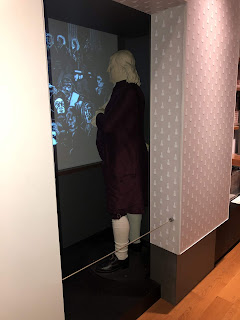(Due to my Nth difficulty publishing my blogs with this device in a readable format- as you may have noticed over the past 10 weeks- it was kindly brought to my attention that this blog, too, never published in the correct way. So here it finally is, in the correct form, for your enjoyment long after the fact)
Here's to my last week at Fort Sumter!
 I began the week out at the Fort, where I excitedly but somberly experienced my last flag raising ceremony. I flexed my EMT skills after an elderly man took a tumble by the cannons and scraped himself, leading to a few band aids, a friendly conversation and still-happy visitor by the end.
I began the week out at the Fort, where I excitedly but somberly experienced my last flag raising ceremony. I flexed my EMT skills after an elderly man took a tumble by the cannons and scraped himself, leading to a few band aids, a friendly conversation and still-happy visitor by the end.
Down at Liberty Square, some knock-off rose sellers have begun soliciting visitors at the entrance (for context, the Gullah Geechee in the area have a tradition of weaving beautiful baskets and decorations like roses, and sell them in specific and clear areas- not including liberty square). All it takes is sight of a marked vehicle and these salesmen scatter, so local PD and our rangers are sure to pass by throughout the day.
 I hit the jackpot this summer and was able to attend a meeting at FLETC Charleston (Super cool facilities including some impressive ships), to discuss joint operations and cooperation throughout a large portion of the Southeast. It's astounding to see so many different law enforcement and military units in one place- SeaHawk, Coast Guard, multiple County PDs, Homeland, DNR, etc.
I hit the jackpot this summer and was able to attend a meeting at FLETC Charleston (Super cool facilities including some impressive ships), to discuss joint operations and cooperation throughout a large portion of the Southeast. It's astounding to see so many different law enforcement and military units in one place- SeaHawk, Coast Guard, multiple County PDs, Homeland, DNR, etc.
A news article came out this week highlighting our park's 'new' rule barring private boaters from docking on the fort or walking up from the sand bar. This sparked hundreds of angry facebook comments and a rally to "blockade!" the fort. To clarify, this rule has been in effect for about a year and had elicited almost no public outcry until this article. There was also the misconception in the media that the sandcar (which is indeed regularly visited by private boaters) is what was closing, which clearly contributed to a large amount of the public anger. The Park Service is no stranger to media attention (good or bad), so while administration has taken the time to communicate with concerned citizens and assure them that their enjoyment of the Fort won't be limited, law enforcement has been sure to focus on what's really important. Namely, the few people -often arising from the internet- who feed off of social media anger and will encourage more radical behavior, and possibly commit some themselves.
I'm not great at goodbyes, so without acknowledging the end of the saga, I'll thank my amazing supervisor/ partner (in/against?) crime, and my brilliant coffee-enabling chief for making good on their promise to make the the "best summer ever".
-











































